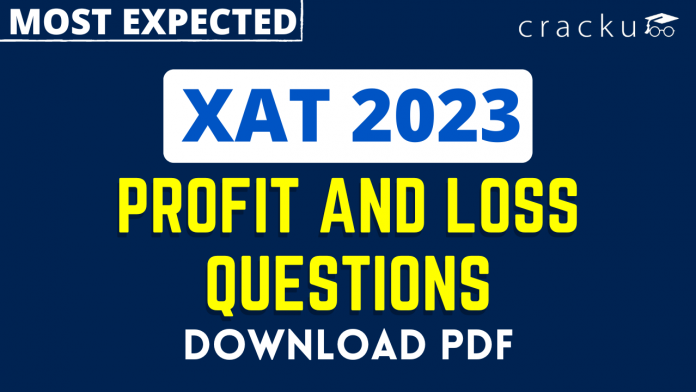XAT Profit and Loss Questions [Most Important]
Download Profit and Loss Questions for XAT PDF – XAT Profit and Loss questions pdf by Cracku. Practice XAT solved Profit and Loss Questions paper tests and These sample questions are to analyse the XAT exam pattern. Top 20 very Important Profit and Loss Questions for XAT based on asked questions in previous exam papers. The XAT question papers contain actual questions asked with answers, and solutions.
Download Profit and Loss Questions for XAT
Enroll to XAT 2023 Crash Course
Question 1: A single discount equivalent to three simple discounts of 10%, 12%, and 15% is:
a) 32.68%
b) 34.17%
c) 37%
d) 35.36%
1) Answer (A)
Solution:
The successive discounts are 10%,12% and 15%
Let the Initial value be 100.
According to question, $100\times\ \frac{\left(100-10\right)}{100}\times\ \frac{\left(100-12\right)}{100}\times\ \frac{\left(100-15\right)}{100}$
i.e; $100\times\ \frac{90}{100}\times\ \frac{88}{100}\times\ \frac{85}{100}$
Discounted value = 67.32 %
Equivalent discount = initial value – discounted value
= 100 – 67.32 = 32.68 .
Hence option A is correct.
Another method :
Discount is also called successive decrease
if x and y are two successive discounts then ,
$x\ +\ y\ -\frac{\left(x\times\ y\right)}{100}$
first we take first two discount 10% and 12%
$\therefore\ 10\ +\ 12\ -\frac{10\times\ 12}{100}=\ 20.8\ \%$
Now we take,
20.8% and 15% ,
$\therefore\ 20.8\ +\ 15\ -\frac{20.8\times\ 15}{100}=\ 32.68\ \%$
Question 2: A shopkeeper sold an article for ₹455 at a loss (in ₹). If he sells it for ₹490, then he would gain an amount four times the loss. At what price (in ₹) should he sell the article to gain 25%?
a) 575
b) 577.50
c) 570.50
d) 115.50
2) Answer (B)
Solution:
Let the loss when the shopkeeper sold the article for ₹455 = L
and the Cost price of the article = C
$\Rightarrow$ C – 455 = L
$\Rightarrow$ C = L + 455……(1)
According to the problem, when the shopkeeper sells it for ₹490, then he would gain an amount four times the loss.
$\Rightarrow$ 490 – C = 4L
$\Rightarrow$ 490 – (L + 455) = 4L
$\Rightarrow$ 35 = 5L
$\Rightarrow$ L = 7
From (1),
C = L + 455 = 7 + 455 = ₹462
Cost price of the article = ₹462
Selling price of the article when the shopkeeper sells at 25% gain = $\frac{125}{100}\times$C
= $\frac{125}{100}\times$462
= ₹577.50
Hence, the correct answer is Option B
Question 3: A shopkeeper marks an article at a price such that after giving a discount of x%, he gains 20%. If the cost price and the marked price of the article are ₹920 and ₹1472 respectively, then what is the value of x?
a) 18
b) 30
c) 20
d) 25
3) Answer (D)
Solution:
Cost price of the article = ₹920
Gain = 20%
Selling price of the article = $\frac{120}{100}\times$920
= ₹1104
Marked price of the article = ₹1472
Discount = x%
Selling price of the article = $\frac{100-x}{100}\times$1472
1104 = $\frac{100-x}{100}\times$1472
69 = $\frac{100-x}{100}\times$92
6900 = 9200 – 92x
92x = 2300
x = 25
Hence, the correct answer is Option D
Question 4: In festival season, a shopkeeper allows a discount of 10% on every item. Even after giving the discount, he makes a profit of 20%. If he does not give any discount, then what will be his profit percent? (correct to 2 decimal places)
a) 33
b) 25
c) 33.33
d) 33.43
4) Answer (C)
Solution:
Let the cost price of the article = 100C
Profit = 20%
Selling price of the article = $\frac{120}{100}\times$100C = 120C
Discount = 10%
$\frac{90}{100}\times$Marked price = 120C
Marked price of the article = $\frac{400}{3}$C
When no discount is provided,
Selling price = $\frac{400}{3}$C
Profit% = $\frac{\frac{400}{3}C-100C}{100C}\times100$
= 33.33%
Hence, the correct answer is Option C
Question 5: A trader bought 640 kg of rice. He sold a part of rice at 20% profit and the rest at 5% loss. He earned a profit of 15% in the entire transaction. What is the quantity (in kg) of rice that he sold at 5% loss?
a) 128
b) 132
c) 154
d) 256
5) Answer (A)
Solution:
Using mixture and alligation method,

Ratio of the quantity of rice sold at 20% profit and 5% loss = 20 : 5
= 4 : 1
Quantity of rice sold at 5% loss = $\frac{1}{4+1}\times$640
= 128 kg
Hence, the correct answer is Option A
Question 6: The cost price of an article is ₹280. A shopkeeper sells it by allowing 16% discount on its marked price and still gains 20%. What is the marked price(in ₹) of the article?
a) 400
b) 360
c) 420
d) 350
6) Answer (A)
Solution:
The cost price of article = ₹280
Gain = 20%
Selling price of the article = $\frac{120}{100}\times$280
= ₹336
Let the marked price of the article = M
Discount = 16%
Selling price of the article = $\frac{84}{100}$M
$\Rightarrow$ 336 = $\frac{84}{100}$M
$\Rightarrow$ M = 400
Marked price of the article = ₹400
Hence, the correct answer is Option A
Question 7: A shop keeper sold an article at four-fifth of the marked price and suffered a loss of $3 \frac{1}{3}\%$. Find the profit percent, if he sold the article at the marked price. (correct to nearest integer)
a) 22
b) 18
c) 21
d) 20
7) Answer (C)
Solution:
Let the cost price of the article = 100C
Loss = $3 \frac{1}{3}\%$ = $\frac{10}{3}\%$
Selling price of the article = 100C – $\frac{\frac{10}{3}}{100}\times$100C
= $\frac{290}{3}$C
Shop keeper sold the article at four-fifth of the marked price.
$\frac{290}{3}$C = $\frac{4}{5}\times$Marked price of the article
Marked price of the article = $\frac{725}{6}$C
Profit percentage when article is sold at marked price = $\frac{\frac{725}{6}C-100C}{100C}\times100$
= $\frac{125C}{6\times100C}\times100$
= 20.833%
= 21% (approximately)
Hence, the correct answer is Option C
Question 8: Trader A gives a single discount of 25% and Trader B gives two successive discounts of 20% and 5% on an identical item. If the discount given by A is ₹320 more than the discount given by B, then what is the marked price (in ₹) of the item?
a) 3200
b) 32000
c) 30000
d) 25000
8) Answer (B)
Solution:
Let the marked price of the item = M
i) Trader A gives a single discount of 25%.
Discount = $\frac{25}{100}$M = $\frac{1}{4}$M
ii) Trader B gives two successive discounts of 20% and 5%.
Price of the item after 20% discount = $\frac{80}{100}\times$M
Price of the item after 5% discount = $\frac{95}{100}\times\frac{80}{100}\times$M = $\frac{19}{25}$M
Total discount given trader B = M – $\frac{19}{25}$M = $\frac{6}{25}$M
According to the problem, discount given by A is ₹320 more than the discount given by B.
$\frac{1}{4}$M = $\frac{6}{25}$M + 320
$\frac{25M-24M}{100}=320$
M = ₹32000
Hence, the correct answer is Option B
Question 9: A customer wanted to purchase an item marked for ₹10000. Shopkeeper offered two types of discounts, 25% flat discount or successive discounts of 14% and 12%. Which is the better offer for the customers and by how much?
a) first offer by ₹68
b) second offer by ₹68
c) first offer by ₹32
d) second offer by ₹100
9) Answer (A)
Solution:
25% flat discount
Selling price of the item = $\frac{75}{100}\times10000$ = ₹7500
Successive discounts of 14% and 12%
Price of the item after 14% discount = $\frac{86}{100}\times10000$ = ₹8600
Price of the item after 12% discount = $\frac{88}{100}\times8600$ = ₹7568
Difference between selling prices = 7568 – 7500 = ₹68
First offer is better by ₹68.
Hence, the correct answer is Option A
Question 10: If selling price of 75 articles is equal to cost price of 60 articles, then the approximate loss or gain percent is:
a) Profit of 25%
b) No profit no loss
c) Loss of 30%
d) Loss of 20%
10) Answer (D)
Solution:
Let the cost price of 60 articles = C
Cost price of 1 article = $\frac{C}{60}$
Selling price of 75 articles = C
Selling price of 1 article = $\frac{C}{75}$
Loss% = $\frac{\frac{C}{60}-\frac{C}{75}}{\frac{C}{60}}\times100$
= $\frac{\frac{5C-4C}{300}}{\frac{C}{60}}\times100$
= $\frac{60}{300}\times100$
= 20%
Hence, the correct answer is Option D
Question 11: The marked price of an article is ₹180. Renu sells it after 20% discount on its marked price and still gains 25%, The cost price (in ₹) of the article is:
a) 120.80
b) 110.80
c) 115.20
d) 125.50
11) Answer (C)
Solution:
Marked price of an article is ₹180.
Discount = 20%
Selling price of the article = $\frac{80}{100}\times$180 = ₹144
Let the cost price of the article = C
Profit = 25%
Selling price of the article = $\frac{125}{100}$C
$\frac{125}{100}$C = 144
C = $\frac{576}{5}$
C = 115.2
Cost price of the article = ₹115.20
Hence, the correct answer is Option C
Question 12: The cost price of an article is ₹250. A shopkeeper gains 20% by selling it at a discount of 36% on its marked price. What is the marked price (in ₹) of the article?
a) 450
b) 380.50
c) 475
d) 468.75
12) Answer (D)
Solution:
Cost price of the article is ₹250.
Profit = 20%
Selling price of the article = $\frac{120}{100}\times$250 = ₹300
Let the marked price of the article = M
Discount = 36%
$\frac{64}{100}\times$M = 300
M = 468.75
Marked price of the article = ₹468.75
Hence, the correct answer is Option D
Question 13: Radha bought a fridge and a washing machine together for ₹57300. She sold the fridge at a profit of 15% and washing machine at a loss of 24% and both are sold at the same price. The cost price of washing machine(in ₹) is:
a) 28650
b) 34500
c) 24500
d) 22800
13) Answer (B)
Solution:
Let the cost price of fridge = x
Profit = 15%
Selling price of fridge = $\frac{115}{100}$x
Cost price of washing machine = 57300 – x
Loss = 24%
Selling price of washing machine = $\frac{76}{100}\left(57300-\text{x}\right)$
According to the problem, both are sold at same price.
$\frac{115}{100}$x = $\frac{76}{100}\left(57300-\text{x}\right)$
115x + 76x = 76$\times$57300
191x = 76$\times$57300
x = 76$\times$300
x = 22800
Cost price of fridge = ₹22800
Cost price of washing machine = 57300 – x
= 57300 – 22800
= ₹34500
Hence, the correct answer is Option B
Question 14: The marked price of an article is ₹5320. It is subject to two successive discounts, the first being 15%, and the second at a rate of 20% of the first. What is the selling price (to nearest ₹) of the article?
a) ₹4522
b) ₹4127
c) ₹4000
d) ₹4386
14) Answer (D)
Solution:
The marked price of an article is ₹5320.
First discount = 15%
Price of the article after 15% discount = $\frac{85}{100}\times5320$ = ₹4522
Second discount = 20% of 15% = $\frac{20}{100}\times$15% = 3%
Selling price of the article after 3% discount = $\frac{97}{100}\times4522$ = ₹4386.34
= ₹4386 (approximately)
Hence, the correct answer is Option D
Question 15: Hari suffered a loss of 8% by selling an article. If he had sold it for ₹300 more, he would have made a profit of 4%. Find his CP (in ₹).
a) 2400
b) 2250
c) 2575
d) 2500
15) Answer (D)
Solution:
Let the cost price of article = 100C
Hari suffered a loss of 8% by selling an article.
Selling price of the article = $\frac{92}{100}\times$100C = 92C
If he had sold it for ₹300 more, he would have made a profit of 4%.
92C + 300 = $\frac{104}{100}\times$100C
92C + 300 = 104C
12C = 300
C = 25
The cost price of article = ₹2500
Hence, the correct answer is Option D





